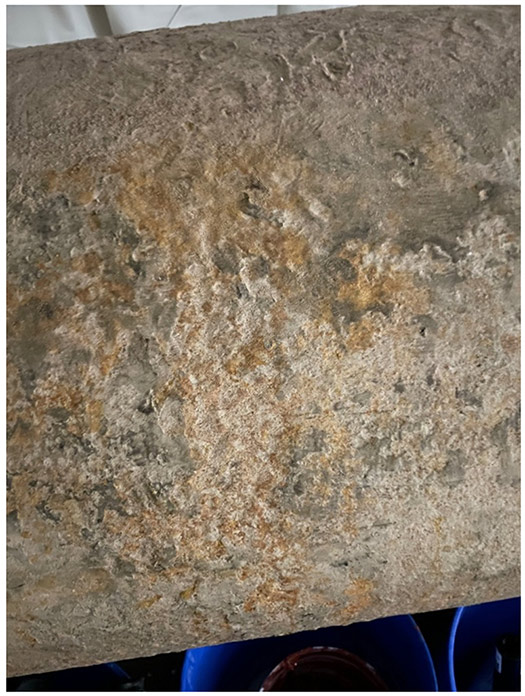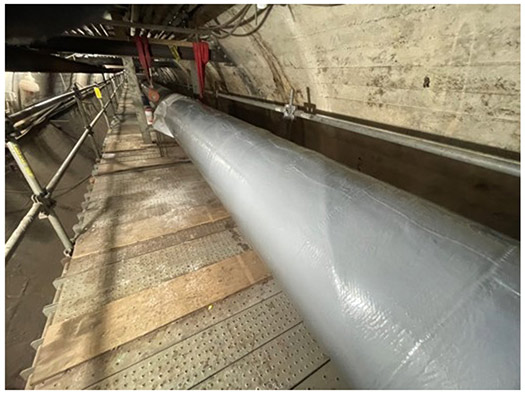March 2024, Vol. 251, No. 3
Features
Common Challenges with Field-Applied Liquid Epoxy Pipeline Coatings
By Russell Giudici, President, Advanced FRP Systems
(P&GJ) — Coatings are an incredibly important part of maintaining safe pipeline operations and asset integrity, including being a first line of defense against corrosion and corrosion-induced failures.
In 2022, corrosion accounted for 22.4% of all incidents in hazardous liquid lines and 11.7% of all incidents in gas transmission lines (PHSMA, 2024). These statistics show that corrosion is a major threat that pipeline operators face, and problems with the protective coating are typically the root cause of corrosion.
Since the 2000’s, fusion-bonded epoxy (FBE) coatings have been and continue to be the standard for most new assets. These shop-applied coatings provide excellent longevity and corrosion protection; however, they are typically welded together in the field, requiring a field-applied coating to be applied. This article will focus on common limitations and challenges having to do with these field-applied pipeline coatings.
Liquid Epoxy
Liquid epoxy coatings are often used for corrosion prevention on large-diameter pipelines because they can be applied in the field, generally do not require extra heat to fully cure, adhere well to steel and FBE Coatings and have less stringent temperature and humidity requirements. These types of coatings are typically 2-part, made up of a base resin and curing agent, and can be applied via brush, roller or airless spray equipment.
Many of the challenges with field-applied liquid epoxy coatings derive from in-field applications. Unlike fusion-bonded epoxy (FBE) coatings, which are typically applied in the lab under very controlled environments, there is much less control over the application environment for field-applied coatings.
In addition, liquid epoxy coatings are typically applied in maintenance and repair situations or over weld seams in new pipeline construction projects. These types of scenarios are associated with complex local geometries, like irregular weld seams, dents, flanges or corrosion pitting. They must also be compatible with the FBE coating and bond effectively with the substrate.
External Factors
As mentioned before, the challenges associated with the lack of control over environmental factors are significant hindrances to effective, field-applied liquid epoxy coatings.
The coating formulation, as well as the material temperature, surface temperature and atmospheric temperature all affect how well the coating will bond with the pipe substrate and any existing coating. Temperature has a significant effect on the viscosity and cure rate of an epoxy coating.
When the coating isn’t applied with the correct material and surface temperature, it will not properly wet out the profile created during the grit blasting stage during surface preparation. Coatings rely on both physical bonding — like an interlocking zipper — and chemical bonding to provide the optimal adhesion level, so proper wet-out is essential.
Repairs on operating natural gas pipelines pose a particular challenge because the steel is usually colder than the air around it, which can lead to condensation forming on the substrate. It is critical that the surface temperature of the pipe is at least 5 degrees F above the dewpoint to prevent condensation.
Further, epoxy coatings that cure in low-temperature, high-humidity environments (or in environments with high levels of carbon dioxide present) can form an amine blush. An amine blush is a surface phenomenon unique to epoxy-type coatings that will completely prevent subsequent layers from adhering properly.
In-Ditch Challenges
Applying and inspecting coatings in a trench differs vastly from in the shop. It is easier in the shop to inspect the full 360 degrees of the pipe and to pull aside a spool that does not pass the QA/QC check. In the field, finding and repairing defects is much more difficult.
Coating inspectors may have only a few inches of clearance around a pipe, requiring the use of mirrors and other devices to see the bottom. Lighting is always a challenge in the field, and many specifications do not require the use of high-voltage holiday testing to find voids in the coating.
Preparation, Application
Liquid-applied coatings generally require an SSPC SP-10 Near White metal blast cleanliness with a 2-3 mil angular profile for proper adhesion. Foreign materials and weld spatter should be removed, and sharp edges must be ground to a radius of 3 mm prior to grit blasting.
Coating over weld seams is inherently more difficult than coating a smooth surface. The topography of a weld seam makes blasting more challenging and significantly increases the risk of air entrapment under the coating.
Solvent-borne coatings are typically cheaper and easier to apply than solvent-free epoxy coatings. They have volatile organic materials like xylenes or methylethylketone (MEK) incorporated in the coating to make them lower in viscosity. When applied too thickly or over pitting and irregular surfaces, these coatings have a tendency to entrap solvent.
Entrapped solvent will often create a premature coating failure. Zero VOC, 100% solid coatings do not have solvents incorporated, eliminating the risk of solvent entrapment and preventing environmental compliance issues with VOC emissions.
When repairs are performed over weld seams, the surface area is fairly small, so the liquid epoxy coatings are most commonly applied via brush or paint roller. Hand application of high-viscosity materials increases the risk of air entrapment. These coatings typically require two or three layers to help reduce the likelihood of any entrapped air pockets extending through the entire coating. When air pockets extend through the coating, water can permeate through the film quickly, allowing subsurface corrosion to occur.
Spray application techniques reduce the risk of entrapped air bubbles but can increase the cost of small projects. If a high-voltage holiday test is possible, it will help eliminate the risk of air entrapment. The formulation of the coating itself significantly affects adhesion, temperature requirements and air entrapment.
Saving money on a low-cost coating can create major problems and actually make the installation cost more because of tighter temperature and application requirements. Consulting a coating expert can help ensure the best material selection, eliminate potential failures and save money on the installation.
When applying a repair to an existing pipeline, it is critical that the repair material adheres well to any existing coatings. Coating materials interact best with like materials. Any epoxy-based system should provide the best levels of adhesion to existing epoxy-type coatings, including fusion-bonded epoxies. Polyureas, polyurethanes and vinyl esters do not adhere as well to existing epoxy base coatings.
Polarity
For wet and semi-wet applications, the polarity of the coating will play a significant role in the longevity of the system. Water permeates through coating systems at different rates, depending on the polarity and cross-link density of the system.
Water will permeate most slowly through low polarity, or hydrophobic coatings. This allows the overall film thickness to be lower without sacrificing service life.
Conversely, if water condensation on the surface during application is a major concern, higher polarity and more hydrophilic coatings can displace the water on the surface and provide proper adhesion even with condensation on the surface. Some epoxy-type coating systems can even be applied underwater. Matching the coating to the application and service conditions is critical to maximizing a coating system's service life.
Case Study
During a routine inspection, a New York gas pipeline operator found corrosion to a key distribution pipeline. The pipe was located inside a tunnel and had been coated with a wax tape system. Installed in the 1940’s, this vintage pipeline was not compatible with smart pigging. The wax tape stopped visual inspection from being able to identify the corrosion without removing the tape coat.
The operator decided to remove the wax tape in sections, to determine the extent of the corrosion. A plan was formulated to protect the pipe from additional corrosion by installing a field applied, solvent free epoxy coating system. The system was designed to be installed in three coats, at 15-20 mils per coat, to provide a 50-year life extension.
Unfortunately, many areas of the pipe had more than 20% wall loss and required a structural reinforcement to continue to operate at the design pressure. Instead of welding external metal sleeves, the operator found it more cost effective to apply a composite repair system around the entire section of pipe. The composite was coated with a solvent free epoxy, and the pipeline was able to return to full operating pressure.
Pipe support areas were reinforced with an aramid composite to provide additional abrasion resistance. Working with a coating expert, this utility was able to adjust to the conditions found and provide the best possible solution for their system.
Improving Processes
To prevent premature coating failures, operators should perform due diligence research and educate stakeholders to raise awareness of these challenges. A high-quality application specification will help address expected challenges and prevent costly change orders or unqualified material trade-outs.
Consulting with a coating expert can help mitigate any project-specific challenges, ensure the quality of an application specification and create a customized QC plan. Onsite quality control should always be carried out by third-party, NACE-certified coating inspectors to ensure the success of any field application.
Author: Russell “Rusty” Giudici is the president of Advanced FRP Systems. Having spent his entire career in corrosion prevention for industrial processes, he supports process engineers, maintenance managers, operators and asset managers in protecting vital infrastructure.







Comments